
Tangency Between 2 Linear Functions and Their Product
Assignment 1
Problem #3
By Erin Cain
In this problem I am asked to investigate the following:
Find two linear functions f(x) and
g(x) such that their product
h(x) = f(x).g(x)
is tangent to each of f(x) and g(x) at two distinct points.
Discuss and illustrate the method and the results.
I am sure that
there are a variety of ways for one to approach this investigation, but I
decided to begin with what I know. Since we are given that the two functions,
f(x) and g(x), are both linear, I know that these functions will be written as
:
f(x) = mx +b
g(x) = nx + c
where m and n are
the slopes of the two functions and b and c are the y-intercepts of f(x) and
g(x). When we multiply these two
linear functions together to get h(x), we will get a polynomial of degree 2,
i.e. a quadratic equation, which when graphed gives us a parabola. Now that we know this graph is a
parabola, we also know that the graph has 2 roots (it crosses the x-axis
twice)and they will most likely be where mx + b = 0 and nx + c = 0. This also tells us that h(x) will cross
the x-axis when f(x) crosses the x-axis and when g(x) crosses the x-axis,
therefore, if there is a point of tangency between these graphs it will be
where they both cross the x-axis.
In order to start
the actual investigation, I picked two arbitrary values for m, n, b, and
c. In order to keep it a little
less complicated, I made all of the values natural numbers. I let m=2 and b=1, f(x) = 2x + 1, and
n=3 and c=4, g(x) = 3x + 4. Using the program Graphing Calculator, I
graphed the functions f(x), g(x), and h(x) = (2x + 1)( 3x + 4). The graph is below:


From looking at
the graph, the first thing that you notice is that f(x) and g(x) are not tangent to h(x), the parabola. Therefore we need to re-think
what numbers we use. When we think
about the standard parabola, y = x2, the tangent lines fall on
opposite sides of the parabola.

From the picture,
we can also notice that if the tangent lines are on the opposite sides of the
parabola, one of the tangent lines must be slanting upward, in other words as
the x values increases the y value also increases, and the other tangent line
must be slanting downward, in other words as the x value increases the y value
decreases. This can be translated
into talking about slope; when one line is slanting upwards it has a positive
slope and when a line is slanting downwards it has a negative slope. Therefore, the lines f(x) and g(x) must
have opposite slopes in order for us to find two linear equations whose product
is a parabola that is tangent to lines.
Now lets try our
last equations of f(x) and f(x) with opposite slopes. So this time f(x) = 2x + 1, g(x) = -3x +
4, and h(x) = (2x +1)( -3x + 4).


Once again, this
did not produce what we were hoping for, but one thing did change. With allowing the slopes to have
opposite signs, this caused our h(x) to become a completely different parabola. Our new parabola is now opening downward
and it moved up and to the right where our maximum point has a positive x and y
value.
Lets now see what
happens when we allow our y-intercepts to be the same number, i.e. b = c. This time we will change both of our
y-intercepts so that they both equal 3.5, but keep the rest of our two
equations the same. Now we are
graphing f(x) = 2x + 3.5,
g(x) = -4x + 3.5, and h(x) = (2x + 1)(-4x +
3.5). LetÕs see what happens:


This time we can
see that 3.5 is possibly too large of a value for our
y-intercepts. We know this because
in order to have our lines f(x) and g(x) tangent to the parabola, our
y-intercept must be above the maximum point of the parabola. Therefore we need
to lower the value we use for our y-intercepts. What happens when we change our y-intercepts
equal to 1?


Our y-intercept
is now getting closer to where we want it.
LetÕs leave the y-intercept alone for a minute and see what happens when
we change our slope. LetÕs let the slopes of our lines be exact opposites of each
other. This in turn will give us
opposite forms of the same lines.
LetÕs begin by making our slopes 4 and -4. The graph will then look like
this:


We are now
getting much closer to what we are looking for. By changing the slopes and making them
equal with the exception of the sign of the slopes, the lines f(x) and g(x) are
on opposite sides of the parabola, but they cross the parabola at two points;
hence the parabola is not tangent to the lines. What if we decrease the slope
by 1?


We are getting
closer!!!! Since we are so close,
letÕs try changing the y-intercept again, but only change it on one of the
equations. Currently our
y-intercept is at 1, so lets cut it in half and make it ½.


The lines are
becoming closer to being tangent, so letÕs make the other y-intercept equal ½
as well.


From first look,
it looks like we have found two linear equations whose product is tangent tithe
two lines. We need to do some
careful examining to make sure this is correct. We can first check that the parabola is
actually tangent to the lines by zooming in on both sides of the parabola.
The Right Side:
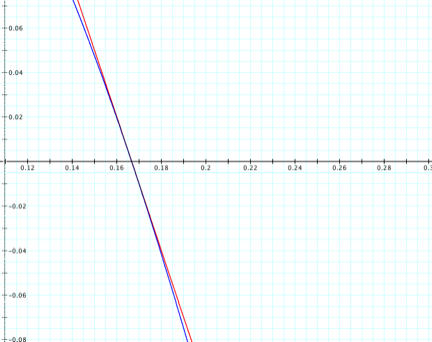
The Left Side:
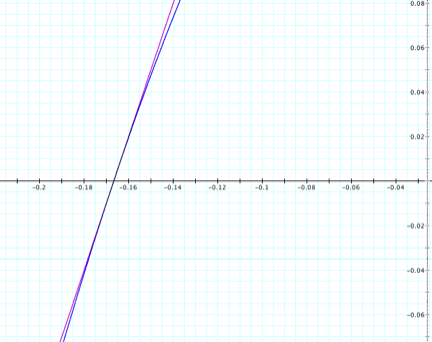
Looking at the
zoomed in pictures, we can see that the parabola is tangent to the lines when
f(x) = 0 and when g(x) = 0. We can
also check this by looking at our equations when the slopes are equal to 1
and-1. Therefore we will have f(x)
=x + ½ and g(x) = -1 + ½ . The graph will look like the following:
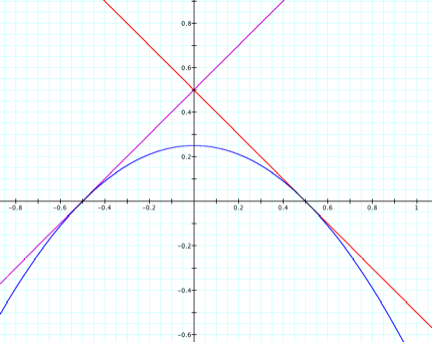

Once again, we
can see that the function h(x) is tangent to the lines f(x) and g(x). As discussed at the beginning of this
solution, the point of tangencies are where f(x) and g(x) cross the
x-axis. Therefore we can graph
these two different solutions on the same coordinate system.
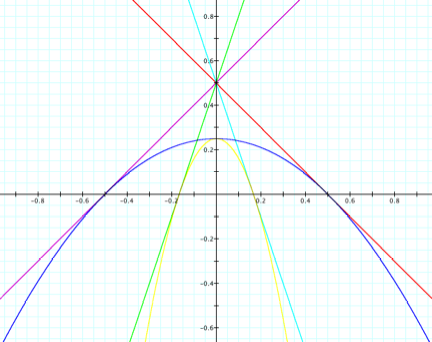

Looking at the
above graph, we notice some similarities between
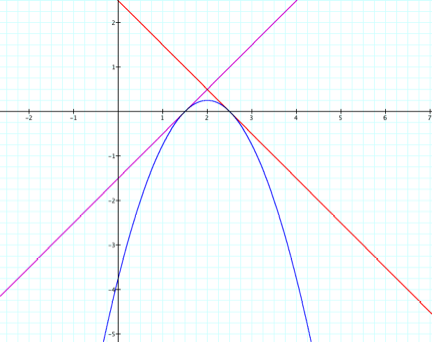

Here we have two
functions, f(x) and g(x) that have opposite slopes and look like they have the
same y-intercept. If we use the
distributive property, we end up with f(x) = x Š 3/2 and g(x) = -x +5/2. Now it is clear from the functions and
the above graph that they do not have the same y-intercept, but because the
slopes are opposite of each other, they still have the same line of symmetry. In this case it looks to by x = 2.
Therefore, we can
generate numerous functions f(x) and g(x) where their product is tangent to
each linear function as long as they have opposite slopes, m and Šm, and the
line of symmetry for h(x) and the two linear functions is parallel to
they-axis.